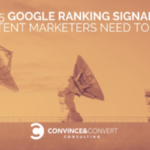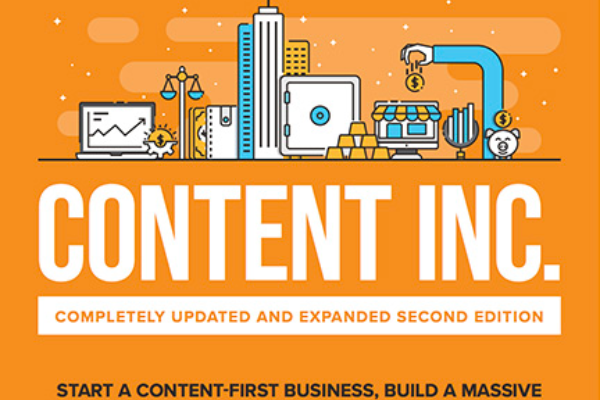
5 Google Ranking Signals Content Marketers Need to Know
June 9, 2020I recently sat in a marketing meeting with one of the largest producers of consumer goods in the world. The discussion centered on building audiences through content in various markets. In some of the markets, the company already had a solid content platform built. In others, there was nothing on the horizon.
The plan being discussed was an acquisition strategy of multiple properties where the organization would approach and, if terms were worked out, buy blogging sites and media properties that already had a built-in audience and content platform.
Sometimes it makes sense to build. Sometimes it makes sense to buy.
Two Things
Blogging sites and media companies have two things that we want and need.
The first is the capability to tell stories. They have the people and processes to churn out amazing content on a consistent basis.
The second, and maybe more important, is that blogs and media sites come with built-in audiences.
Although merger and acquisition strategies have been happening ever since the first media company was launched, nonmedia companies are starting to get into this game recently. Photography supplies store Adorama put a buying group together when JPG magazine was going out of business. The group got access not only to JPG’s Content Inc. platform and content, but also to JPG’s 300,000 subscribers (which just happen to be Adorama’s prospects and customers).
L’Oreal, the global makeup conglomerate, purchased Makeup.com from Live Current Media for over $1 million back in 2010. Marketing automation company HubSpot wanted to add an agency blog to match its marketing and sales blogs, so it approached Agency Post and acquired the blog instead of starting fresh. In mid-2015, the SurfStitch Group, a leading online retailer in Australia, purchased two small media companies in the surfing industry, further positioning SurfStitch as the clear content leader in the category.
As you build out your content marketing strategy to grow your industry dominance, acquisition strategies are a natural path to follow.
The Process of Acquiring a Content Platform
Content Marketing Institute purchased multiple properties to add to its platform, including a West Coast conference called Intelligent Content Conference and an awards program dubbed (fittingly) the Content Marketing Awards. We made the decision that purchasing these platforms made more sense than creating them from scratch and then competing with these properties.
To acquire new platforms, follow these seven steps.
Step 1. Determine Your Goal
Like any good business decision, start by determining the reasons it might possibly make sense to purchase an existing content platform. Your business objectives for a purchase might include:
- To cover a geographic area that your business is currently absent from with an in-person component. The ultimate goal would be to reach more customers for cross-selling, up-selling, and decreasing your customer turnover rate in that region.
- To insert your brand into the conversation around a topic you are not well known for. Let’s say you manufacture a certain type of steel, and you’ve identified some use in the oil and gas industry. It may then make sense to look at smaller oil and gas blog sites or events and immediately become a credible part of the industry lexicon.
- To accomplish subscription objectives. Most likely, the platform will come with a built-in audience for you to nurture, grow, or leverage for cross-selling.
- To purchase the content assets themselves and the associated search engine optimization and sharing benefits with them.
Step 2. Clearly Identify the Audience
For this to work, you need a clear understanding of the audience gap you are trying to fill. For example, CMI targets senior-level marketers at large organizations with their magazine, Chief Content Officer. CMI targets marketing, PR, social media, and SEO managers and directors (the “doers”) at mid-market and larger enterprises for Content Marketing World(CMI’s event).
Step 3. Make Your Short List of Platforms
After you identify your objective and your audience, start making a list of relevant platforms that will help you meet your goals. The key is to avoid setting any limitations at this point. You can list events, blog sites, media sites, association sites, and maybe even some sites directly from your influencer list.
When you are making the list, it’s handy to put it all into a spreadsheet containing relevant subscriber information such as:
- Origination date.
- Current number of subscribers.
- Known revenue sources (list each of them).
- Ownership structure (for example, independent blogger or media company).
For a conference or trade show, here is a list of assets we look for when purchasing an event:
- Number of attendees (past two years) with percentage of growth (or loss).
- Number of exhibitors (past two years) with percentage of growth (or loss).
- Number of media partners (past two years).
- General regional location.
- Registration cost (rate card).
- Marquee value (this is a subjective rate determining the cache for the event—a five-point scale should work just fine).
- Possibility for setting up a media platform around the event (again, something on a five-point scale is sufficient). The idea here is that there may be potential to build the event into a fully functional media platform with online content, web events, and more.
Step 4. Approach the Best Opportunity
There are two approaches I recommend, and I’ve seen both of them work. You can reach out to your top pick and see where the conversation goes. The issue is that you are putting all your eggs in one basket. A better option may be to approach your top three picks all at once and convey your intentions (i.e., that you are interested in purchasing their website, event, etc.).
You’ll likely be amazed at the reactions you receive. Some of the operators will never have imagined that they’d be approached on a purchase. Others (probably those with a media background) will already have an exact idea of their exit strategy and what they are looking for.
The key at this point is to get discussions started so you can gauge where potential interest may lie. Worst-case scenario when approaching a possible seller that isn’t interested in selling is that you now have the potential to grow a relationship from this first contact. Simply put, you never know when intentions might change, and now you have an inside track if they do.
Step 5. Determine the Purchase Value
There is a standard measure to smaller web properties and events (we will get to that in a second), but this first part is critical: figure out what the owner wants. Just like you do with your influencers, it’s your job to find out what the platform owner’s goals and aspirations are. Maybe it’s just monetary (though this is unlikely). Perhaps the owner is looking for a new opportunity, or he or she desperately wants out of the business (many blog site owners or event owners never imagine that their project might get larger than what they can manage or might grow in a different direction than what they intended).
As I said, there is a proper valuation process for smaller web properties and events. To do this, you both need to sign a mutual nondisclosure agreement for protection—on both sides. Then you want to request the business’s profit and loss statement for the previous two years, at least. You may also need to see documentation on current sponsorship agreements and other contracts the company holds to confirm that its P&L statement can be verified. (Important note: Legal specifics can vary widely, so please consult your legal representation before you approach any opportunity.)
For website purchases, some deals are done on a “per-subscriber” basis, some on a net profit basis. In one example I personally worked on, a media deal was based on paying $1 per subscriber. In another, it was five times earnings, paid out over a two-year period. Smaller conferences generally go for around five times net profit (for example, if the annual profit of the conference is $100,000, you would pay $500,000 for the property).
Let’s look at a small conference example:
- Attendees: 250
- Exhibitors: 20
- Revenue: $340,000
- Expenses: $270,000
- Net profit: $70,000
General value of the business: $70,000 × 5 = $350,000
There is a bit more that goes into it, but the estimated general value of this event would be around $350,000.
Step 6. Make Your Offer
Before you make a formal offer, you want to make sure that your price is in the right ball park and that the owner agrees to the basics of your terms. If you have that agreement, you’ll need the event owner to sign a formal letter of intent (LOI). The LOI basically means that both sides agree to continue the conversation and take the relationship to the next level of the process; it’s the business acquisition equivalent of getting engaged—while it’s not a meaningful or legally binding act in and of itself, it serves as an official statement of your intentions. (Note: Please consult legal representation on creating an LOI.)
Step 7. Final Negotiations
Now, before you sign anything, consider these final questions:
- What e-mail and print lists are available? What permissions do you have to send to the company?
- What assets are available? Videos? Blog posts? Podcast episodes? Conducting a full audit of the company’s assets might be necessary.
- What are the social channels in use?
- Who are the prime influencers in this space that we should connect with? Request contact details and areas of expertise (if needed).
- What vendors does the company work with? Whom would it recommend?
Over the following 30 to 60 days, you would be working on a formal asset purchase agreement and reviewing all the documentation to make sure all facts, figures, and discussions are accurate and verifiable. From there, contracts are signed, followed by corks being popped on your celebratory bottles of champagne (optional, but a nice touch).
This article is an edited version of Chapter 20 from Content Inc.




